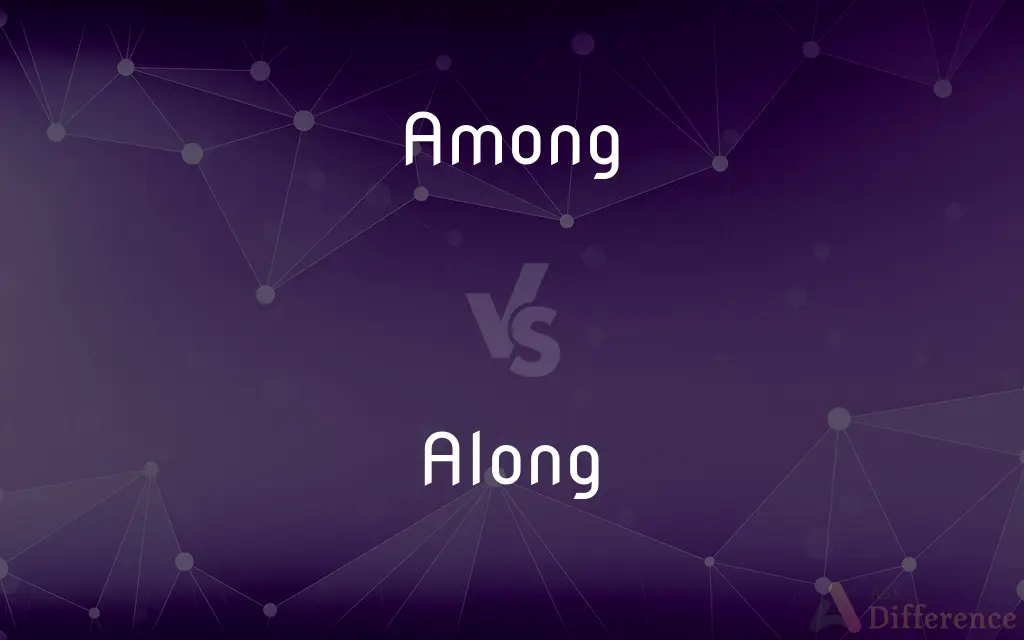Among vs. Along — What's the Difference?
By Fiza Rafique & Urooj Arif — Updated on March 15, 2024
"Among" denotes being in the midst or surrounded by others, typically used when referring to things that are part of a group or mass. "Along" indicates movement or presence in a line parallel to the length of something, often a path or surface.

Difference Between Among and Along
Table of Contents
ADVERTISEMENT
Key Differences
"Among" is used to express a relationship involving several parties or elements, highlighting inclusion or a sense of being part of a larger group. It conveys a sense of mingling or dispersion within a collective, suggesting no specific order or arrangement. For example, when you say "She walked among the flowers," it implies she is surrounded by flowers without specifying a path. On the other hand, "along" is used to describe something that follows the length of a path, border, or surface, suggesting a linear movement or arrangement. Saying "She walked along the path" indicates movement parallel to the path's course, with a clear direction and alignment.
When discussing relationships or positions within a group, "among" serves to illustrate an element's connection to others in a more general, collective sense. It's about being part of a larger entity without implying any linear arrangement. Conversely, "along" often implies a continuous movement or presence, focusing on the proximity and parallelism to a physical or metaphorical line, such as a road or narrative thread.
In terms of usage, "among" fits best in contexts where the focus is on the interaction or relationship between members of a group, or when something is distributed, shared, or located within a collective. For instance, discussing how a secret is known among friends. "Along," however, is chosen to express alignment, direction, or progression, especially in physical space, like describing how trees are planted along a street.
"Among" suggests an immersion within a group or area, evoking a sense of envelopment or scattering. This preposition is particularly useful when the exact position is less defined, more about being surrounded by or involved with others. "Along," in contrast, invokes a clear, linear path or proximity, emphasizing a parallel or adjacent position that is elongated, like a river running through a landscape or a journey along a coast.
While "among" highlights a collective or inclusive aspect, implying a sense of belonging or inclusion without specific order, "along" emphasizes a directional or positional relation, often linear and alongside something lengthy. These distinctions make "among" suitable for discussions about general involvement or presence within a group, and "along" apt for indicating movement or location in relation to something elongated.
ADVERTISEMENT
Comparison Chart
Definition
In the midst of, surrounded by, or included within a group or mass.
Moving or extending horizontally on, beside, or parallel to.
Usage Context
Refers to relationships or positions within a group.
Indicates direction, movement, or presence along a path or line.
Spatial Concept
Suggests immersion or being surrounded without a specific order.
Implies a linear progression or arrangement.
Example
"The only red flower among the whites."
"Walking along the riverbank."
Connotation
Inclusion, part of a larger whole.
Alignment, directionality.
Prevalence
Used with items part of a group or collective.
Used when referring to movement or position next to something.
Visual Imagery
Being in the center or surrounded by others.
Following a path or being parallel to something.
Relationship
Non-specific, general inclusion or participation.
Specific, indicating a direct path or proximity.
Compare with Definitions
Among
With one another.
The siblings shared the toys among themselves.
Along
Beside; next to.
A row of trees ran along the fence.
Among
Part of; included in.
One name among the list caught my attention.
Along
In company; together with.
Bring your friends along to the picnic.
Among
Shared by; involving.
The profits were divided among the partners.
Along
In a line parallel to the length of something.
The park stretches along the river's edge.
Among
Located or occurring in a group.
A thief hid among the crowd.
Along
Forward, onward in space or time.
As we moved along the trail, the scenery changed.
Among
Surrounded by; in the company of.
She found herself happy among friends.
Along
Throughout (an extent in space or time).
Flowers bloomed along the path in spring.
Among
Situated more or less centrally in relation to (several other things)
You're among friends
Flowers hidden among the roots of the trees
Along
Over the length of
Walked along the path.
Among
Being a member or members of (a larger set)
Snakes are among the animals most feared by man
A British woman was among the 54 victims of the disaster
Along
On a line or course parallel and close to; continuously beside
Rowed along the shore.
The trees along the avenue.
Among
Occurring in or shared by (some members of a group or community)
Members of the government bickered among themselves
A drop in tooth decay among children
Along
In accordance with
The committee split along party lines over the issue.
Among
Indicating a division, choice, or differentiation involving three or more participants
The State Council would elect a temporary president from among its members
The old king called the three princesses to divide his kingdom among them
Along
Forward; onward
We drove along, admiring the view. Farther along, we passed a hitchhiker.
Among
In the midst of; surrounded by
A pine tree among cedars.
Along
As company
Bring your friend along.
Among
In the group, number, or class of
She is among the wealthy.
Along
In accompaniment or association; together
Packed an atlas along with other books. See Usage Note at together.
Among
In the company of; in association with
Traveling among a group of tourists.
Along
With one; at hand
Luckily, I had my camera along. Our guests should be along soon.
Among
By many or the entire number of; with many
A custom popular among the Greeks.
Along
(Informal) Advanced to some degree
My father is getting along in years.
Among
By the joint action of
Among us, we will finish the job.
Along
By the length of; in a line with the length of; lengthwise next to.
Among
With portions to each of
Distribute this among you.
Along
In a line with, with a progressive motion on; onward on; forward on.
Among
With or against one another
Don't fight among yourselves. See Usage Note at between.
Along
In company; together.
John played the piano and everyone sang along.
Among
Denotes a mingling or intermixing with distinct or separable objects. (See Usage Note at amidst.)
How can you speak with authority about their customs when you have never lived among them?
Along
Onward, forward, with progressive action.
Don't stop here. Just move along.
Among
Denotes a belonging of a person or a thing to a group.
He is among the few who completely understand the subject.
Along
By the length; in a line with the length; lengthwise.
Some laid along . . . on spokes of wheels are hung.
Among
Denotes a sharing of a common feature in a group.
Lactose intolerance is common among people of Asian heritage.
Along
In a line, or with a progressive motion; onward; forward.
We will go along by the king's highway.
He struck with his o'ertaking wings,And chased us south along.
Among
Mixed or mingled; surrounded by.
They heard,And from his presence hid themselves amongThe thickest trees.
Along
In company; together.
He to England shall along with you.
Among
Conjoined, or associated with, or making part of the number of; in the number or class of.
Blessed art thou among women.
Along
By the length of, as distinguished from across.
The kine . . . went along the highway.
Among
Expressing a relation of dispersion, distribution, etc.; also, a relation of reciprocal action.
What news among the merchants?
Human sacrifices were practiced among them.
Divide that gold amongst you.
Whether they quarreled among themselves, or with their neighbors.
Along
Now heard only in the prep. phrase along of.
Along
With a forward motion;
We drove along admiring the view
The horse trotted along at a steady pace
The circus traveled on to the next city
Move along
March on
Along
In accompaniment or as a companion;
His little sister came along to the movies
I brought my camera along
Working along with his father
Along
To a more advanced state;
The work is moving along
Well along in their research
Hurrying their education along
Getting along in years
Along
In addition (usually followed by `with');
We sent them food and some clothing went along in the package
Along with the package came a bill
Consider the advantages along with the disadvantages
Along
In line with a length or direction (often followed by `by' or `beside');
Pass the word along
Ran along beside me
Cottages along by the river
Common Curiosities
When should I use "among" instead of "along"?
Use "among" when referring to being in the midst of or included within a group or mass, where there's a sense of distribution or mingling.
Is "among" used only for physical proximity?
No, "among" can also refer to non-physical relationships, such as being among the top students or secrets known among friends.
Can "among" and "along" be used interchangeably?
Generally, no, because "among" implies being part of a group or mass without specific arrangement, while "along" suggests a linear relationship or direction.
How does "along" express companionship or inclusion?
"Along" can imply companionship or inclusion in activities or journeys, suggesting someone or something accompanies or is part of a progression.
Does "among" imply equality within a group?
Not necessarily equality, but it does suggest inclusion or being part of a larger whole without highlighting hierarchy or order.
Is "among" suitable for describing a situation with only two elements?
Typically, "among" is used when referring to three or more elements, while "between" is preferred for two.
Can "along" indicate a direction without physical movement?
Yes, "along" can indicate direction or alignment even in metaphorical senses, like a narrative moving along a thematic line.
How do "among" and "along" differ in visual imagery?
"Among" evokes imagery of being surrounded or interspersed without order, while "along" depicts a line or path that is followed or paralleled.
Can "along" be used to describe time as well as space?
Yes, "along" can describe progression through time, as in "along the course of history."
How does context affect the choice between "among" and "along"?
The context determines which preposition is appropriate, based on whether the focus is on inclusion within a group or movement/direction alongside something.
Share Your Discovery

Previous Comparison
Put vs. Lay
Next Comparison
Advanced vs. FluentAuthor Spotlight
Written by
Fiza RafiqueFiza Rafique is a skilled content writer at AskDifference.com, where she meticulously refines and enhances written pieces. Drawing from her vast editorial expertise, Fiza ensures clarity, accuracy, and precision in every article. Passionate about language, she continually seeks to elevate the quality of content for readers worldwide.
Co-written by
Urooj ArifUrooj is a skilled content writer at Ask Difference, known for her exceptional ability to simplify complex topics into engaging and informative content. With a passion for research and a flair for clear, concise writing, she consistently delivers articles that resonate with our diverse audience.














































